Text
Dance Team Profile: Choreo Cookies

Choreo Cookies is a hip hop dance team, established in 2002. Founded by Emmett Agapay, the team describes itself on their official website as “a batch of garage dancers” that decided to form Choreo Cookies “in attempts to pursue their passion for performance and appreciation for the art of dance.” What began as a group of high school friends from the city of Oceanside in North county San Diego eventually evolved into a team of currently 30 members that spans across San Diego County. Since 2007, Choreo Cookies has acted as the competitive adult hip hop dance team for Studio 429, a hip hop only dance studio that teaches to all ages and skill levels and was established in 2006 in North County. The team is currently under the direction of Keone Madrid and Kristen Aguinaldo.
Choreo Cookies has participated in numerous competitions and shows over the years including:
· The Bridge Dance Competition (Whittier, CA)
· The Bridge- East Coast Dance Competition (New York, CA)
· Fusion Dance Competition (San Diego, CA)
· Vibe Dance Competition (Irvine, CA)
· World of Dance (Pomona, CA)
· Body Rock Dance Competition (San Diego, CA)
· Urban Street Jam (Anaheim, CA)
· San Diego County Fair (Del Mar, CA)
· Studio 429’s Friends & Family Dance Expo (Escondido, CA)
· Urban Paradise (San Francisco, CA)
· Sockhop (San Francisco, CA)
· Private parties, charity events, and shows across San Diego County
Websites/Social Media:
http://www.studio429.com/cc/ccinfo/index.php
http://www.youtube.com/playlist?list=PLDFEDBD72CAF748FA
https://twitter.com/KeoneMadrid
7 notes
·
View notes
Text
Dance Team Profile: SGBM

The SuperGalacticBeatManipulators, or SGBM, were founded on November 12th, 2005 by JabbaWockeeZ dancer Kevin Brewer. Alongside the Boogie Monstarz (based in Sacramento and founded by JabbaWockeeZ member Phil Tayag), Press P.L.A.Y (also based in Sacramento and founded by another JabbaWockeeZ member Joe Larot), and the JabbaWockeeZ themselves, these four dance crews form the collective Family Royale. Currently in its seventh generation, SGBM’s lead directors/coordinators are known as The Galactic Council: Justin J. Vaughn as “The Overlord” (Executive Director), Ryan "Suave" Estacio as “Beta Prime” (Captain), Cye Bongalos as “Gamma Prime” (Captain), and Jasmine Adamos as “The Oracle” (Administrative Assistant). The team currently resides at StudioFX in the Miramar area of San Diego, and at SoCal Dance in the Sorrento Valley are of San Diego.
Notable performances:
Body Rock
VIBE
USA Hip Hop Dance Championship
World of Dance LA
Urban Paradise
Del Mar Fair
Fusion
Culture Shock
Ultimate Brawl
Public Display
Websites/Social Media:
https://www.facebook.com/SuperGalacticBeatManipulators/info
6 notes
·
View notes
Text
Check out the awesome commentary and conversation we've started. Thank you Sean for the valuable commentary! Keep it going! Reblog and add your own two cents. We love getting feedback and seeing this passion among the Asian American youth of our generation.
So yesterday we received the following message:
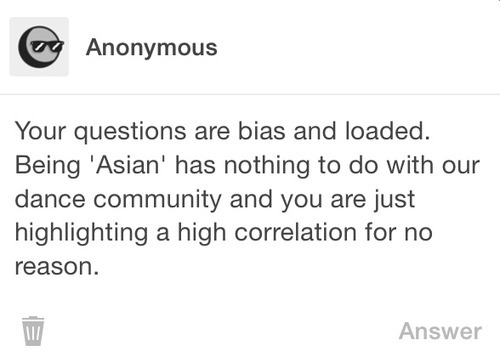
We’d very much like to address the problem to save from future misunderstandings. We are very grateful for the feedback and continue to encourage feedback. We recognize that perhaps our questions were not properly phrased so we first apologize...
#asian american#asian american studies#in movement#hip hop#dance#socal#aas 55#aas#uci#irvine#uc irvine
64 notes
·
View notes
Text
Dance Team Profile: MCIA

Profile by Michelle Chiu
Mission Statement
Modern Completely Insane Anteaters, MCIA, is an exhibition hip-hop dance team that gives its members opportunities to dance, grow, and have fun while upholding the values of respect, family, and our roots.
"I will always be humble, I will always be thankful, I will always love MCIA" - Alex Pantig, founder of MCIA
Brief Introduction
MCIA (Modern Completely Insane Anteaters) was established in 2003 by Alex Pantig, an UCI alumni. The original intention of creating MCIA was to provide entertainment in the form of hip-hop to the UCI Basketball games and MCIA was able to do just that and more. Since then, MCIA has slowly earned their place and gained reputation in the hip hop dance community. To this day, they continue to perform for the basketball games at UCI as well as other UCI events such as VIBE dance competition, UCI Care-a-thon, and Anteater Awards. They also perform for events around Southern California such as at various nightclubs, or at the Clipper's basketball game.
MCIA and Social Media
Social Media plays a big role in today's society, especially video sharing sites such as Youtube. Many dance teams such as Quest Crew, KABA Modern, and CADC would upload their performances to these video sharing sites as a way to not only advertise to other audiences that are not in their local area, but to also allow others who were not physically there, to be able to watch their performance. This is also a way to show their audience what their dance team is capable of doing, which means that MCIA, too, is no exception. Below is a video of MCIA's most recent performance at Kenya 2014. Please enjoy.
Social Media
Website: http://www.mciadanceteam.com/home.html
Facebook: https://www.facebook.com/mciadanceteam
10 notes
·
View notes
Text
Dancer Profile: Charles Joseph Zepeda
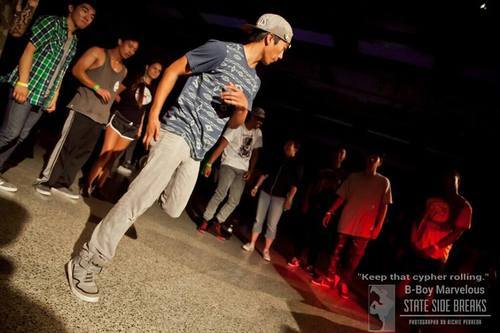
Interviewed by Mary Whitman
1. Name
Charles Joseph Zepeda (B-Boy Marvelous)
2. Age
19
3. Hometown/Current location
San Diego, CA
4. When and how did you begin dancing?
7th Grade at Rancho Del Rey Middle School in Chula Vista, CA
5. What dance teams or projects have you been a part of?
Teams/ Crews I have been/ am a part of include: Urban Pandas Crew (discontinued), Cloud Walkers Crew [CWC] (current), Surreal Fidelity Dance Team (alumni), Full Effect Show Choir (alumni), Stateside Breaks [of San Diego State University] (current)
6. What are you currently working on now?
I am currently not working on anything special. I just attempt at being the “cypher king” for breaking jams I go to just to establish not only my name, but my crew’s name, Stateside Breaks.
7. What is the importance of a majority of SoCal dancers being Asian?
I believe there is no importance to a majority of Southern California’s dancers being predominantly Asian. There is too much value put on ethnicity that one may lose sight of what it is truly valuable; that being skill, passion, character, and will.
8. What do you think is the relationship between hip hop and the Asian American community?
In terms of the relationship established within the Asian-American community and hip-hop, I believe that within the community Asians believe they have a strong relationship to hip-hop culture, but other ethnicities not involved in Asian-American hip-hop fail to recognize the contribution made by Asian-Americans. “Samurai Champloo” was a great example of Japanese culture blending with hip-hop culture. Anime and hip-hop established by legend Nujabes brought life to old Asian-American culture, including The Way of the Ronin (Samurai). Unfortunately things such as this are unrecognized. Society sticks with stereotypes like “Asians can dance” or “White people can’t dance” which leads to misconceptions. Hip-hop and Asian-American culture may never establish a firm relationship that is universally recognized until ignorance has ceased.
9. What does it mean to be an Asian American dancer?
To be an Asian-American dancer means to spread awareness that hip-hop and Asians do have prominent role in the culture. This however creates a label that draws attention away from my capabilities and character. I do not want to be labeled as an Asian-American dancer, but rather a dancer who happens to be Asian-American.
10. Who are your Asian American dance inspirations?
Inspirations for dance I have include:
Allan Twiford {Cypher City Kings [CCK]/ Stateside Breaks} He had first inspired me to start dancing when I was in 7th Grade and he was in 8th. I saw him battle someone and I told myself I wanted to do that.
Daniel Campos (B-Boy Cloud) {Skill Methodz Crew} I have always appreciated Cloud’s style as well as speed, which is a skill I crave when I break.
Quest Crew (Season 3 Winners of America’s Best Dance Crew) The work of Quest Crew had inspired me to go further when I was highly active in the b-boy community within my community.
Stateside Breaks (San Diego State University breaking crew) My crew always inspires me to improve with every battle and performance. I cannot be where I am today without their love and support.
#Charles Joseph Zepeda#bboy marvelous#urban pandas crew#cloud walkers crew#surreal fidelity dance team#full effect show#stateside breaks#csusd#hiphop#bboy#dance#asian american studies 55#aas55
8 notes
·
View notes
Text
Dancer Profile: Way "Funk Shui" Chen
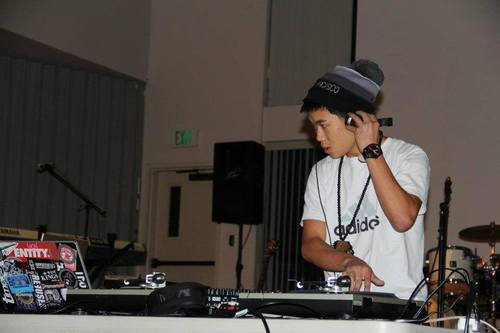
Interviewed by Mary Whitman
1. Name: Way (Funk Shui)
2. Age: 20
3. Hometown/Current location: Fremont/Irvine
4. When and how did you begin dancing?
I began dancing in junior high when I went to the first dance of the year. I didn’t know how to dance, but I was so excited that I was just jumping up and down the whole night. After that night, there was never a day that I didn’t dance.
5. What dance teams or projects have you been a part of?
I joined Fresh Dynamix in 2010, I was a part of the Academy of Villains in 2011 when they were still in San Mateo, and I am currently in Kaba Modern. I have been repping BlockheadZ Family (East Bay) since 2011 with my brothers Nick Morales, Abel “Strange Abe” Del Toro, Cody “Koi” Carlson, Devon “Seven” Stout, and Alcatraz Shez.
6. What are you currently working on now?
I am currently training and focusing on popping technique and popping related styles. I am also doing some research on Hip-Hop culture and history and how it relates to our generation.
7. What is the importance of a majority of SoCal dancers being Asian?
It is not important for a majority of SoCal dancers to be Asian. Taking an ethnocentric viewpoint on anything Hip-Hop related is unhealthy for the community. Hip-Hop is about embracing other cultures, crossing the boundaries of ethnocentricity and racism, and gaining respect through raw skill, regardless of social standing, race, or sexual orientation.
8. What do you think is the relationship between hip hop and the Asian American community?
The Asian American community has contributed its fair share to the Hip-Hop cypher in the recent decades, mainly through dancing. Asian Americans brought their own culture into the melting pot, just as Latina/os and African Americans did.
9. What does it mean to be an Asian American dancer?
Being an Asian American dancer means you’re an Asian American dancer, nothing more and nothing less. I believe that people should create meaning with their art internally, not externally. Nationalities and ethnicities are just labels; people shouldn’t label their art as such.
10. Who are your Asian American dance inspirations?
Most of my inspirations are not Asian American. However, some dope Asian Americans that really get down are Tetris, Bionic Man, and Boy Wonder.
#way#funk shui#dynamix#academy of villians#kaba modern#blockheadz family#tetris#bionic man#boy wonder#asian american studies#aas55#dance#hiphop#popping#mary whitman
8 notes
·
View notes
Text
Dancer Profile: Nick Sosa
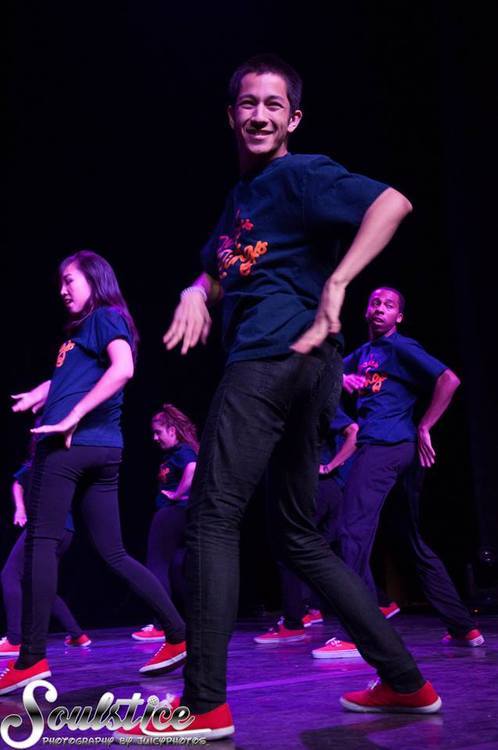
Interview conducted by Taylor Weik
1. Name
Nickolas Sosa
2. Age
21
3. Hometown/Current location
Chino Hills/Irvine
4. When and how did you begin dancing?
Of course there are the high school dances where you can just dance for fun, but I started dancing my senior year of high school when doing a dance event for one of my high school clubs. Ever since then, I had always wanted to dance. It wasn't until college and coming to UCI that i really, truly began dancing though.
5. What dance teams or projects have you been a part of?
I joined MCIA Dance Team my first and second year and then my third year I was lucky enough to be able to dance with Common Ground. I have been on Kenna Inc., Griminalz, The H&M Project and directed my own project called Peaches & Rings.
6. What are you currently working on now?
I am currently just a dancer on Common Ground and working hard for the upcoming competition, Body Rock.
7. What are your thoughts on dance as a platform for Asian Americans?
I dont really see dance as a different platform for Asian Americans in comparison to any other races. Dance is a place of equality and of course people have their reasons for dancing, but it is a place where we are all similar.
8. Who are your Asian American dance inspirations?
Without a doubt, Gina Hong. Being lucky enough to work with her this year has not only pushed me as a dancer, but has given me a greater understanding of my body. She is truly amazing and shows me exactly how dance can be a language that we all speak and understand.
9. How do you use social media as a dancer?
As a dancer, I honestly use YouTube to watch a lot of dance-related videos; as weird as that may be, it's true. Facebook as well is a place where I hear about events happening in the community, and where most teams communicate when outside of practice.
#Nick Sosa#dance#asian american#aas55#hip hop#MCIA#Common Ground#Peaches and Rings#Soulstice#UCI#community#taylor weik
6 notes
·
View notes
Video
youtube
ACA hip hop dance team performing at Prelude Norcal in 2013 and placing first in the competition.
6 notes
·
View notes
Text
Dance Team Profiles: CADC & ACA
Profile By Michelle Chiu
Messages
CADC: "Dance is for everybody. I believe that the dance came from the people that it should always be delivered back to the people."
ACA: "Love dance for dance itself and never stop"
Brief Introduction:

CADC (Chinese Association's Dance Crew)
CADC was founded in 1994 at UCI and since then, it has progressed and is now a well-known dance crew within the Southern California's hip-hop dance community. CADC is a strictly collegiate team. Members of the CADC dance teams must be an official UCI student as well as part of UCI's Chinese Association (CAUCI). CADC emphasizes the importance of having fun through competitive and exhibitive hip-hop dancing focusing on culture through the understanding of tradition and the necessity for change.
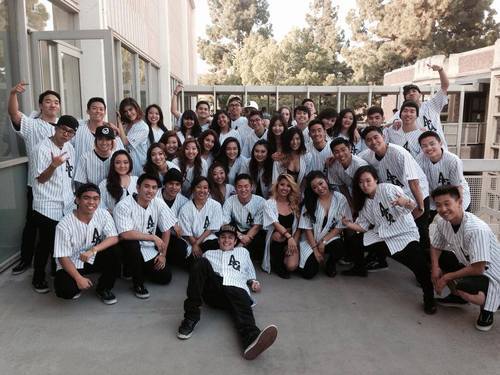
ACA (Association of Chinese Americans) Hip Hop
ACA hip-hop was founded in 1993 at UCLA, and like CADC, has made its way and earned its place as one of the best dance crews within the Southern California's hip-hop dance community. Like CADC, ACA hip-hip is affiliated with their school's Chinese Association, ACA. ACA hip-hop is comprised of dancers that share a passion for dancing and performing. Their main goal is to inspire and be inspired as they continue to secure their place in the dance community.
Notable Performances and Recognitions:
Below are just a few of the many awards these dance these received. A completed list can be found on their website or other social websites.
CADC
2013- All Cal Champions
2012- All Cal Champions
2010- Winner of Showdown
2010- Placed second in Ultimate Brawl
2009 - Placed second on The Bridge
2009- Winner of Showdown
2009- Placed third in Hip Hop Internationals USA
ACA
2013- Winner of Prelude Norcal
2013- Placed 2nd in Urban Street Jam
2008- Winner in Battle Royale
2007- Placed 6th in Prelude
Upcoming Events:
Sunday 06/01/14: CADAC will be hosting workshops featuring Patrick Packing, Jeffrey Caluag, Jaymes and Jonah from 2:00 - 6:30pm at the Mesa Parking Structure, 4th Floor
Social Media:
CADC
Website: http://www.cadcuci.net/cadc/
Twitter: https://twitter.com/CADANCECREW
ACA
Facebook: https://www.facebook.com/acahiphop?v=info
Youtube: https://www.youtube.com/user/acahiphop
Tumblr: https://www.tumblr.com/tagged/aca-hip-hop
6 notes
·
View notes
Text
Dance Team Profile: GRV
Profile by Jason Beunaflor
Mission:
This team was created to inspire, be inspired, & promote positivity.
About GRV:
GRV is a competitive dance team founded in 2007. The team resides in Walnut, California and was started by David Lim, Jeff Baluyut, Angelie Descalzo, & Valerie Meneses. On the name GRV, founding member David Lim wrote on the group’s Tumblr page:
“I always see people asking what GRV stands for. So, I’ma clear it up for everyone. We got GRV from the word “groove,” but in no way do we intend for it to mean “groove”. The reason why GRV doesn’t have a meaning and doesn’t stand for anything is because WE DIDN’T WANT A WORD TO DEFINE US OR HELP DESCRIBE US. We just let our dancing do that. IT’S OUR DANCING THAT GIVES A DEFINITION TO THE WORD GRV AND NOT THE OTHER WAY AROUND.”
In 2010 – 2011, the directors of GRV were David Lim, Jesse Trinidad, and Jonathan Aledia and the team had 51 members. GRV includes several well-known dancers who have participated in other notable dance crews such as Jawn Ha and Bam Martin of Mos Wanted Crew (Martin has also danced part of Boxcuttuhz). The team also consists of sub-groups such as GRaVy Babies (the GRV Junior Team) and G-Fam (consisting of GRV and GRaVy Babies).
Notable Performances and Recognitions:
GRV has competed in several dance competitions including World of Dance LA, VIBE dance competition, The Bridge, and Fusion Hip Hop Dance Competition.
2011
World of Dance LA – 2nd place
VIBE XVI – 2nd place
Fusion XII – 2nd place
The Bridge – 1st place
2012
World of Dance LA – 1st place
World Hip Hop Dance Championships – 2nd place
The Bridge – 1st place
2013
World of Dance LA – 1st place
VIBE XVIII (G-Fam) – 1st place
The Bridge – 2nd place
2014
World of Dance LA – 2nd place
7 notes
·
View notes
Text
Dancer Profile: Brandon Leong

Interview conducted by Beverly Luu
1. Name
Brandon Leong
2. Age & Ethnicity
22, Chinese/Japanese/Caucasian
3. Hometown/Current location
Mission Viejo, CA/Irvine, CA
4. When and how did you begin dancing?
My first memories of me dancing are from when I would try to imitate the movements while watching my parents’ VHS tapes of Michael Jackson’s “Moonwalker,” Michael Flatley’s “Lord of the Dance”/”Riverdance,” and Cirque du Soleil’s “Nouvelle Experience” at about five years old. These performances all fascinated me as a young child, but I never pursued dance beyond the living room during those years. In sixth grade, my mom encouraged me to try an all-boys intro class to hip hop and breaking at Mission Viejo Dance and Performance Arts Center (now known as South Coast Conservatory) because I was becoming a chunky 12 year-old. She noticed my likening for playing the violin and Dance Dance Revolution as a kid and thought that dance lessons would be a good active hobby for me since swimming, basketball and soccer had all fallen out of my interest in the past. Plus, she wanted me to be one of the guys who had cool dance moves at middle school dances…too bad I didn’t even end up going to any until high school because I was too shy. I credit my parents and my first coach Dennis “DC” Caindec (former Culture Shock Los Angeles artistic director) as the jump-starters to my dance career.
5. What dance teams or projects have you been a part of?
Teams and projects that I have been a part of include: MVDPAC Co-ed Hip-Hop Competition Team, Kreative Movement (Kaba Kids), Vitamin D, UCI’s KASA Freshmen Dance-off team, Urban Motus, Kaba Modern, Project Groovement, The David Lee Project, KM Legacy and Insight jazz dance ensemble.
6. What are you currently working on now?
I am currently working towards finishing the last requirements for my bachelor’s degree in Psychology and Social Behavior at UC Irvine, developing a career path for myself, and gaining new life experiences in general. In terms of dance, I am now dancing with KM Legacy, exploring new areas with Insight jazz dance ensemble at UCI and re-evaluating both what dance means to me as well as how I can creatively utilize my talents to better those around me.
7. So I ran into you at the Empire of Funk conference last week and Kaba Modern founder, Arnel Calvario, was one of the speakers at the conference. Was there anything he said in particular that struck you as being important in terms of being a Hip Hop dancer?
I have spoken with and heard from Arnel numerous times in the past, and his words never fail to inspire me. Yet, one of the ideas he expressed at the Empire of Funk conference that resonated with me the most was his belief that having API (Asian-Pacific Islander) representation in the mainstream has the power to validate those who may have felt alienated otherwise. While there is a lot of politics, stereotyping issues, and RESPONSIBILITY involved with being a minority figure in popular media, having somebody in the cultural space that one can relate to can spark a form of self-efficacy in a person to positively change his/her life forever. On a mass scale, the former could potentially empower an entire community.
8. What do you think is the relationship between hip hop and the Asian American community?
It really is difficult to understand this relationship, as many communities do exist within the generalized umbrella term of “Asian Americans/API’s”, not to mention the instances of other intersectionalities of gender, class, sexual orientation, ability, etc. However, what we do know is that API’s have been involved in the cultural production of hip-hop for several decades and that many continue to occupy a stake in its evolution today. In general, I think hip hop acts as a medium for empowerment for marginalized persons.
9. In mainstream media, such as film and television, there is an underrepresentation of Asian Americans in terms of dance but here in SoCal, a majority of dance teams have a good number of Asian American dancers. What does it mean to be an Asian American dancer in the wider scope of things?
While Asian American dancers remain underrepresented in the mainstream today, I believe they have definitely obtained a huge increase of media exposure within the last decade. However, there is still a lot of work to be done in order for us to achieve some type of ideal “grand justice.” As an Asian American dancer, I see my position as an opportunity to demonstrate to others the complexity of cultural phenomena like hip-hop, as well as the diversity of peoples which they impact. It is important to note that while Asian Americans are institutionally ostracized, other groups also experience their unique set of problems, and advocating for the voice of one group should not necessarily be prioritized over the other.
10. As a dancer, what is the greatest lesson you've learned so far?
Dancing has provided me with so many situations and people to learn lessons from! However, I think the most valuable thing I have gained from dance is the authentic validation from my peers and mentors that has shaped me to be more confident in being myself and pursuing my endeavors.
11. How do you balance dance, school, and work (if you are working)? Do your parents worry about it affecting your grades?
In the past, the way I prioritized my time often contributed to dips in my achievement at work, school and dance. At some points I have also experienced stress within my interpersonal relationships, as well as declines in my physical and mental health. While my parents have worried about the consequences of my past decisions, it helped me learn to take responsibility for my own actions. I believe that finding balance in life is a constant struggle, especially when having many resources available can cause me to form higher expectations for myself. Yet, assessing what is most important to me and training myself to stay task-oriented have been processes that I practice to keep me happy. As my past coordinator Dana Roy once taught me, living simply can have the most rewarding results.
12. So when Kaba Modern was on America’s Best Dance Crew, it was a big deal because Asian Americans were on MTV, mainstream media. We were probably in middle school at the time. Do you remember watching them on TV and did you ever think that in a few years, you’d be a part of that dance crew?
Actually, my first exposure to Kaba Modern occurred at Vibe 10, when I attended my first ever collegiate dance competition in January 2005. After Kaba Modern performed and won first place that year, I became really excited about the group and followed them in the only way I knew I could: by purchasing the Vibe DVDs for the following two years (since nobody uploaded full shows onto YouTube those days). I returned to Vibe three years later at Vibe 13, which was the same month when ABDC aired their first episode of the audition round with Kaba Modern. Seeing Modern’s set at Vibe and Kreative Movement’s performance in the pre-show was just a confirmation that I wanted to be part of the family. A month later in February 2008 I made it onto Kreative Movement and the rest is history. Not even when I was on Kreative did I believe I would be dancing for my dream team later on…it really was a humbling experience to gain that honor in 2011.
13. How do you think YouTube plays a role in the dance community today?
YouTube plays an integral part in the expansion of the dance community. It provides a platform for massive amounts of people to access nearly unlimited amounts of inspirational material online. Likewise, it allows for anyone with internet and a video recording device to upload their dancing to the network for users to view; anybody has the chance to share their artistry or enterprise themselves to the world. It truly is an amazing phenomenon to see how information can spread globally in an instant, especially if it can have a positive effect on those who receive it. On the flip side, the high saturation of dance videos online also has the potential to induce a level of disunion and ignorance in the dance community. Firstly, YouTube users now have the option of experiencing performances and workshops virtually rather than attending events in person…it saves time and lots of money! Sometimes just watching a video can feel like enough, even without physically interacting with the people who were there. Secondly, YouTube acts as an indirect mode of “education” for some viewers, especially with dancers who use the website as a primary source for learning dance. This surface-level of learning leads the risk of awareness of dance history being lost, as anyone can now post their own teachings for others to follow. Paired with consumption of so many readily available videos/workshops/dance groups to choose from, a lack of deep engagement with these resources can lead to a diluted pool of common knowledge. Lastly, YouTube has helped push an underground movement more into the mainstream, meaning that people have taken advantage of dance by further commercializing it into an industry. When dance is approached as a business, the availability of space where dance is shared for free can be sacrificed. Thus, the privatization of many high quality dance resources confines the knowledge only to and for the financially privileged. There are many pros and cons to the interplay between YouTube and dance, and it is our responsibility to study this in order to have any control of the future of our community.
14. Who are your Asian American dance inspirations?
I’ve come across way too many to list! The people inspiring me the most at the moment are those who are using their artistry in highly innovative, strategic manners and those who are generating critical discussion about dance in their respective social circles.
#brandon leong#kaba modern#kababayan#uci#uc irvine#abdc#asian american studies#asian americans#beverly luu
18 notes
·
View notes
Text
Thank you!
Thank you all for the support you've been giving us these past two weeks. You guys are awesome! Keep liking, reblogging and sharing our blog! We appreciate every note and every follower. Thank you!
9 notes
·
View notes
Text
Dancer Profile: Kyle Yamasaki

Interview conducted by Beverly Luu
1. Name
Kyle Yamasaki
2. Age & Ethnicity
18, Japanese
3. Hometown/Current location
Monterey Park
4. What college are you currently attending?
East Los Angeles College
5. When and how did you begin dancing?
I started dancing my junior year of high school when one of my closest friends encouraged me to try out for the All Male Dance team at my high school.
6. What dance teams or projects have you been a part of?
I was on my high school team Mark Keppel All Male Dance Team and now I am currently dancing for GRV.
7. What are you currently working on now?
My team GRV is currently working on a set to compete at Body Rock in San Diego.
8. Why do you think so many dancers in SoCal are Asian?
Though I agree there are large communities of Asian dancers in SoCal, there are also so many other ethnicities who are talented and it’s great to see this melting pot of dancers collaborate and expand their boundaries.
9. What do you think is the relationship between hip hop and the Asian American community?
I feel that other than your typical Asian sports such as ping-pong and tennis, dance gives us a chance to express ourselves in another way to show a different side of us.
10. In mainstream media, such as film and television, there is an underrepresentation of Asian Americans in terms of dance but here in SoCal, a majority of dance teams have a good number of Asian American dancers. What does it mean to be an Asian American dancer in the wider scope of things?
To me I feel that when it comes to dancing, your ethnicity doesn't matter because when you're dancing, no one looks to see what ethnicity you are. They look to see what you can bring to the floor/stage and how you interpret your style of dancing.
11. How do you balance dance, school, and work (if you are working)? Do your parents worry about it affecting your grades?
I try to work around my schedule for everything so that none of it conflicts with the other. School of course is my number one priority and I make sure to do any school work first before I have to go to dance practice.
12. So I know you posted a concept video recently for your girlfriend. So can you explain where inspiration for your concept video came from? How do you think YouTube plays a role in the dance community today?
My inspiration came from her. I feel that she always does so much for me and that I lack to show my appreciation for her and all that she does; so I felt this would be a good way to surprise her on her birthday and show my love and appreciation. Youtube plays a big role in the dance community because it allows us to expose our choreography to the world and show our passion for dance.
13. Who are your Asian American dance inspirations?
Wow. There are just so many. I guess when I first started out dancing, my inspiration came from Jawn Ha and Bam Martin. But of course I can never forget my roots and I still look up to my past All Male Dance Team alumni and captains: Gilbert Truong, Jonathan He, Jonathan Phung, Alex Tang, Kenyou Sasaki, Calvin Dang, and Nathan Phung.
Check out Kyle on instagram at kyamaha4!
Also, check out Kyle's concept video for his girlfriend, Lucia!
#GRV#kyle yamsaki#world of dance#body rock san diego#gravy babies#g fam#world of dance los angeles#wod#beverly luu#in movement#dance#socal dance#hip hop
13 notes
·
View notes
Text
Dancer Profile: David Lee
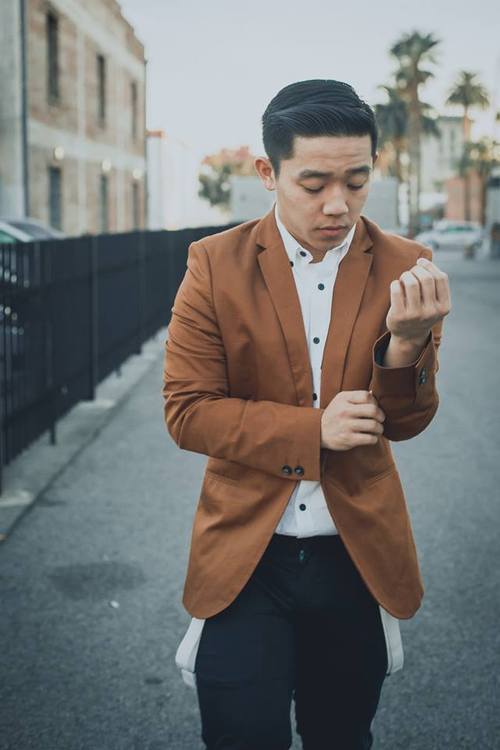
Interview conducted by Taylor Weik
1. Name
David Lee
2. Age
23
3. Hometown/Current location
Alhambra, CA
4. When and how did you begin dancing?
Nov. 2006 during my Sophomore year at Alhambra High School.
I saw AHS’s All Male Dance Team performing during an assembly and was really interested in learning how to dance. Took initiative and enrolled in my first dance class at Jayvee Dance Center.
Didn’t take it seriously until I was invited to be apart of the first generation of BZ Offspring. Wasn’t until then that I realized that I could make a profession out of it.
5. What dance teams or projects have you been a part of?
Boogiezone Offspring, Boogiezone Breed, Soul Fresh, Main Ingredient, CADC, Culture Shock LA, Maker Empire, Movement Project, Griminalz and The David Lee Project.
6. What are you currently working on now?
I’m collaborating with other choreographers to gain experience and to open up my dance vocabulary. Also:
- Community Outreach events with Culture Shock LA
- Teaching three hip hop classes a week (Mondays at The Lab (6 p.m., 7 p.m.), Thursdays at Boogiezone Utopia (8 p.m.))
7. On dance as a platform:
People of Asian ethnicity often become the stereotype of being studious bookworms who are forced to choose an extracurricular such as tennis or some sort of musical instrument. In recent years, TV shows such as ABDC and movies like Step Up steered that “stereotype” towards another form of art - dance. The first few seasons of ABDC received a lot of publicity and certain groups - Kaba Modern, Jabbawockeez, Poreotics, Quest Crew, Mixed Elements - had a few (or all) members with an Asian American background. It’s shows and movies like these that gave the Asian American community opportunity in the industry but at the same time, made dance mainstream. With dance being mainstream, it slowly provides an outlet for Asians outside of that stereotype. Workshops, dance teams, competitions, choreographers, and dancers began to popcorn from all over.
In the end, dance and hip hop really is something that the Asian American community takes pride in. Dance is a language spoken by the body, regardless of ethnicities; and because of this, many Asian American dancers have begun to pursue this career path.
8. Who are your Asian American dance inspirations?
Anthony Lee, Bam Martin, Agnes Loyola, Sorah Yang, Gina Hong, Ellen Kim, Ryan Feng, Keone & Mariel Madrid, Ray Basa, Paul Ross and Mike Song.
9. How do you use social media as a dancer?
Social media is the prime spot to share my or other peoples work with friends and the rest of the world. I usually post my video (which was uploaded onto Youtube) onto Facebook so people can like, comment, share, etc. I also use it to publicize if I’m teaching anywhere that week or for future workshops.
I use Trance, a new app made strictly for dancers. It allows you to upload your work on the app and everyone else who has the Trance App can ‘like’ other videos.
#David Lee#asian american#hip hop#aas55#dance teams#dance#UCI#socal#media#youtube#CADC#the David Lee project#taylor weik#626#alhambra high school#alhambra high#alhambra ca#alhambra#626 represent
31 notes
·
View notes
Text
Dancer Profile: Anh Dang
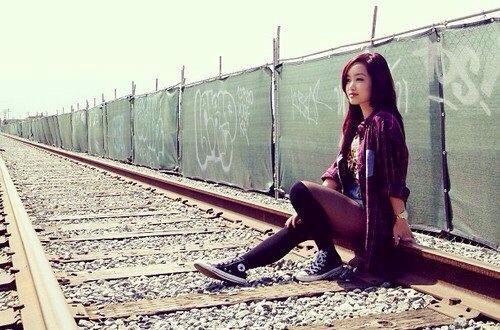
Interview conducted by Beverly Luu
1. Name:
Anh Dang
2. Age
20
3. Hometown/Current location:
San Francisco/Irvine
4. When and how did you begin dancing?
I started dancing around the beginning of my freshman year of highschool. One of my friends whom was really into dancing at the time actually started to show me some videos of certain choreographers that she had liked and I was instantly hooked on these dance videos. My friend then told me about a local dance team and encouraged me to audition for them. With no prior dance experience, I was sure I wouldn’t have a chance of making it but I just wanted to tryout and take the class to see what it was all about. I distinctively remember how inviting and welcoming everyone were and how positive the environment was. After meeting the director and talking to him about wanting to possibly join a team, he invited me to start coming to practices and just jump in on their set that was in the works for their next performance and just like that, I officially joined my first dance team, Junior Fusion.
5. What dance teams or projects have you been a part of?
I have been on Jr Fusion (F.U.S.I.O.N. SF), Funksters (Funkanometry SF), and Common Ground dance team. As for projects, I’ve been a part of Kenna Inc., ASL, Clarence Bitun Project, and Natalia Garcia Project.
6. What are you currently working on now?
Currently, I’m not part of any teams because I just wanted to focus more of my time on school but I do still try my best to take workshops here and there. Being in projects also gives me the opportunity to still dance and perform without a hectic schedule.
7. What is the importance of a majority of SoCal dancers being Asian?
I don’t think there is necessarily an importance in the majority of dancers here being Asian. It does, however, serve as a way or outlet for Asians, as well as other ethnicities, to come together to create a unique and welcoming community to be a part of and I think that’s why being in the dance community is such a great experience for everyone all around.
8. What do you think is the relationship between hip hop and the Asian American community?
I think many of us nowadays are very drawn to the hip-hop culture. It was indeed very foreign to our ethnic group some time in the past but over the past decade or so, it has been more and more accepted as something appealing and has grown to become something familiar to us, especially in this generation. Hip hop has been structured into a different way of expression for many. Some of our traditional parents may have viewed the hip-hop culture as a negative influence at some point or another through stereotypical views but in this generation, we know that it is just a different way of telling a story and showing how we feel through music.
9. What does it mean to be an Asian American dancer?
I think it just means that there is another outlet for us to use music and our bodies as a means of expressing ourselves and using dance as a way to take a break from our everyday lives. You can be stressed or caught up with everything that’s going on in your life but when you’re dancing, whether it’s in a class or with a team, the positive and uplifting energy from the people around you will tend to make you forget about those worries for a moment and just simply dance. It definitely creates a healthy outlet for us to be inspired by others in order to push ourselves to improve, de-stress through exercise, and through networking with others who share the same passion as well. I believe it also helps our character in one way or another because when you’re dancing, whichever piece it may be, you have to be able to really feel and portray the mood of the song and by doing so, it helps us break away from our comfort zone in order to find the side of us we may have not known we had. If you’re on a team, it also helps strengthen your ability to work with others and to cooperate as a whole. When your teammates are giving you their all, it is only fair for you to do the same for them and by pushing each other through positive encouragement, we all grow together, and that’s just one of the few rewarding aspects of being a dancer.
10. Who are your Asian American dance inspirations?
Gina Hong! She’s been my dance inspiration even before I joined CG and I was just lucky enough to be trained by her during the time that I was on the team.
#anh dang#common ground#fusion#funksters#gina hong#dance#uci#socal dance#in movement#i'm in movement#beverly luu
21 notes
·
View notes
Text
In Movement: Our Mission
So yesterday we received the following message:
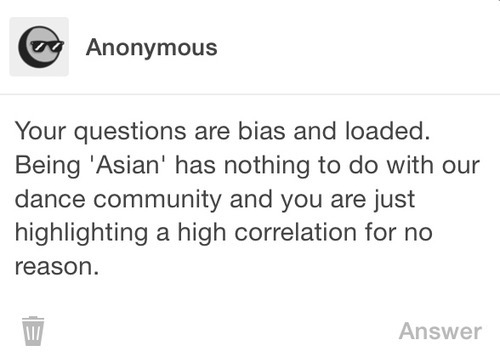
We'd very much like to address the problem to save from future misunderstandings. We are very grateful for the feedback and continue to encourage feedback. We recognize that perhaps our questions were not properly phrased so we first apologize if there was an offense that was made. But as an Asian American studies project, we are indeed focusing on Asian Americans and here's why:
In Movement's mission is to highlight Asian American involvement in the Southern California hip hop dance community. While not all members of this diverse community identify as Asian American, we find it important to raise awareness of those who do and who use their talents to express themselves through outlets not previously occupied by those of Asian descent.
We wish to examine dance as not just a hobby, but a lifestyle. We want to examine hip hop as a way for Asian Americans to build community and to make themselves known.
If we look at all the facets of hip hop, we realize there's a deficit of Asian American representation in all these areas. But here in Southern California, many Asian Americans have found their niche in dance and have become inspirations to those like just like them. We watch YouTube videos and see these people who look just like us doing something we love to do, allowing us to find that positive Asian American image in our generation's main form of media (YouTube) that strays from the stereotypical representations, like the tech savvy geek, the math nerd and the woman warrior, that we often find in mainstream media such as film and television.
Regardless of the topic, the genre or the medium, we will always fall under this burden of representation... but that's just part of the battle. In light of the new generation and all our hopes to keep moving forward, we are pleased to spotlight and commend those who have stepped forth in movement of the Asian American Movement, whether they realize their historical impact or not.
Because we are all pioneers of a new movement. We are all In Movement.
#our mission#in movement#taylor weik#beverly luu#we are in movement#dance#socal dance#uci#aas55#asian american studies#anon
64 notes
·
View notes
Text
Dance Team Profile : Kaba Modern
Kaba Modern performing at VIBE XIII at UCI's Bren Event Center in 2008.
Profile by Michelle Chiu
Mission:
"We are a family committed to utilizing our passion for the art of dance to inspire and cross all boundaries within diverse communities through artistic expression, humility, constant growth, and respect for all people." -- Kaba Modern
About Kaba Modern:
Kaba Modern is a collegiate dance group founded by Arnel Calvario in 1992, who was a member of University of California Irvine's Filipino cultural club, Kababayan (meaning "countrymen" or "compatriot" in Tagalog). Calvario originally founded the group to perform at the "Modern Suite" for Kababyan's annual Pilipino Cultural Night (PCN), and since then, Kaba Modern has evolved into one of the best Hip-Hop dance crews in California. Kaba Modern is part of a bigger entity called KM Kollective which also includes KM Legacy (alumni based group) and Kaba Kids (members 18 or younger).
Notable Performances and Recognitions:
Kaba Modern has competed and won many regional, national and international dance competitions and performances such as VIBE, Fusion, Hip Hop International, VIBE, Body Rock, Prelude Norcal Competition and America's Best Dance Crew.
2007- placed 2nd in the World Hip Hop Dance Championships
2008- placed 2nd at VIBE XIII
2008- placed 3rd in the World Hip Hop Dance Championships
2008- placed 3rd in MTV America's Best Dance Crew (participants are Jia Huang, Cindy Minowa, Lawrence Kao, Yuri Tag, Tony Tran, and Mike Song)
2011- winner of the Prelude Norcal Competition
Brief History of Hip Hop:
Hip hop first began to develop in New York City at Bronx when street parties became increasingly popular. The rise of DJs and turntables, and the integration of kids b-boxing and break dancing was when the dance style known as "hip hop" began to take its shape. Now hip hop encompasses many dance styles such as breaking, locking and popping. What makes hip hop unique from other forms of dance is that it is often "freestyled" and is often used when engaging in dance battles.
Kaba Modern Now:
Kaba Modern is still growing even to this day, gaining more and more supporters. They continue to participate in many dance competitions and school performances.3"Kaba Modern has created a worldwide street dance culture that has given Asian Americans more visibility and respect in Hop Hop and in American popular culture." -- A Hip Hop Story to Tell by DJ Kuttin Kandi
Upcoming Events:
Kaba Modern will be having their next performance at UCI's Humanities Gateway Cross Cultural Center Friday May 23, 2014 at 6 p.m.
Social Media:
Facebook: https://www.facebook.com/kaba.modern
Youtube: http://www.youtube.com/user/kabamodern
Twitter: https://twitter.com/KabaModern
Website: http://www.kabamodern.com/

Kaba Modern 2012-2013 season pictured above
#uci#kaba modern#KM#dance teams#hip hop#empire of funk#kababayan#america's best dance crew#ABDC#vibe#socal#asian american#asian american studies#aas55#michelle chiu
13 notes
·
View notes